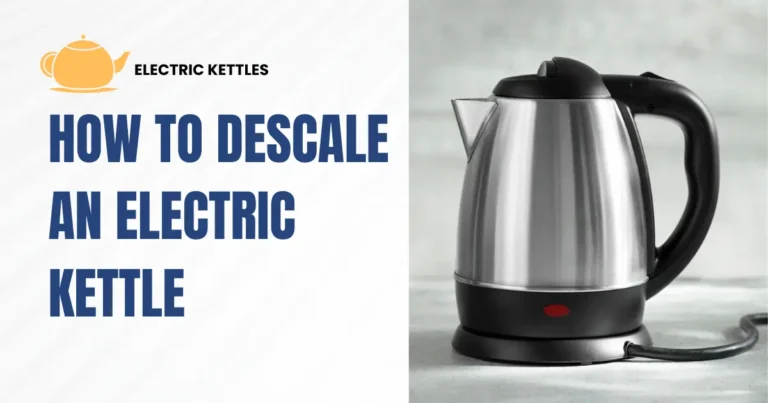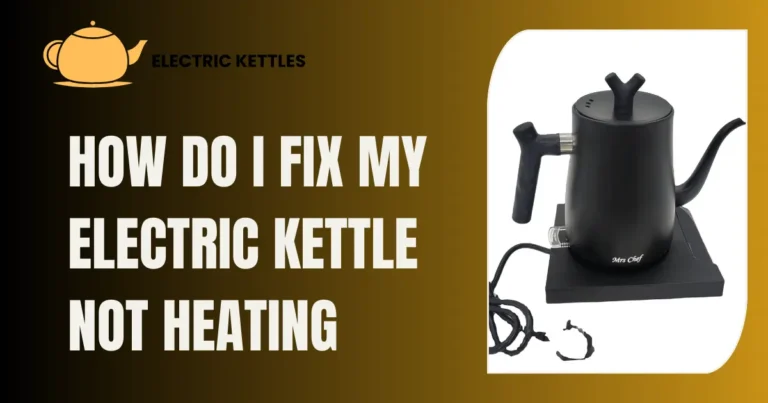How to Know When Electric Kettle Is Done
Electric kettles are popular appliances used to boil water quickly. They are faster than traditional stovetops and are easy to use. Most electric kettles have an automatic shut-off feature that turns the kettle off when the water reaches boiling point. This feature makes them safe and convenient. Many models also have additional features, like temperature settings and keep-warm functions.
If you leave the kettle on too long, it may overheat or damage the appliance. Understanding the indicators, like steam or an automatic shut-off, helps prevent accidents. It also ensures you get the best taste from your hot drinks. Whether you’re making tea, coffee, or instant noodles, using water at the right temperature is key.
Table of Contents
Electric Kettle Functions
Electric kettles are designed to make boiling water quick and easy.
- Boiling Water: The primary function is to boil water rapidly. Most electric kettles can bring water to a boil in just a few minutes, saving time compared to using a stove.
- Automatic Shut-off: Many electric kettles come with an automatic shut-off feature. This means the kettle will turn off by itself once the water reaches boiling point. This feature helps prevent overheating and keeps the kettle safe to use.
- Boil-Dry Protection: This function protects the kettle from damage. If the kettle is turned on without water inside, it will automatically shut off. This prevents the heating element from burning out.
- Temperature Control: Some advanced models allow you to set specific temperatures for different types of beverages. For instance, you can boil water to 80°C for green tea or 100°C for black tea.
- Keep-Warm Function: This feature keeps the water at a desired temperature for a period. It’s useful if you want to enjoy multiple cups of tea or coffee without waiting for the kettle to boil again.
- Cordless Design: Many electric kettles have a cordless design, allowing you to lift the kettle off the base for easy pouring. This adds convenience and makes it easier to serve hot beverages.
Indicators That Show the Kettle Is Done
When using an electric kettle, several indicators can signal that the water is boiling and the kettle is done.
1. Automatic Shut-off
Most electric kettles come equipped with an automatic shut-off mechanism. This feature ensures that once the water reaches the boiling point, the kettle will turn off on its own. This not only saves energy but also prevents potential overheating or damage to the kettle. It’s a key safety feature, especially for those who might forget to turn the kettle off.
2. Audible Alerts
Many modern kettles are designed with built-in alarms or beeps that sound when the water reaches boiling. This audible alert is particularly useful for busy kitchens or for those who may step away while the kettle is heating. It provides a clear indication that your water is ready, allowing you to return to the kettle promptly without needing to monitor it constantly.
3. Steam Emission
As the water heats up, steam will start to rise from the spout of the kettle. When you see a steady stream of steam, it indicates that the kettle is close to boiling and is nearly done. This visual cue is a helpful reminder to prepare your cups or ingredients while waiting for the kettle to finish.
4. Bubbling Sound
As the water begins to boil, you may hear bubbling sounds inside the kettle. This noise typically increases as the water reaches a rolling boil, which is when bubbles rapidly break the surface. Listening for this bubbling sound can help you determine the kettle’s readiness, especially if it doesn’t have an automatic shut-off feature.
5. Indicator Light
Some kettles include an indicator light that illuminates during the heating process. This light typically turns off when the water has boiled. This visual cue provides an easy way to know when your kettle is done without needing to check manually. It’s a simple yet effective feature that adds to the convenience of using an electric kettle.
Visual Cues to Watch For
When using an electric kettle, several visual cues can help you determine when the water is boiling and the kettle is done. One of the most noticeable signs is the steam emission. As the water heats up, steam will begin to escape from the spout. A consistent and strong flow of steam indicates that the water is close to boiling, signaling you to prepare for pouring.
Another key visual cue is water bubbling. Initially, you’ll notice small bubbles forming at the bottom of the kettle. As the temperature rises, these bubbles will grow larger and break the surface. When you hear a vigorous bubbling sound, it usually means the water has reached a rolling boil and is ready for use.
You may also observe water movement in the kettle. The surface will become agitated as the water heats up, and this churning motion becomes more pronounced as it approaches boiling. Additionally, if your kettle has a transparent lid or viewing window, condensation forming inside can indicate that the steam is rising and the water is heating up.
Manual Monitoring Techniques
Timing Your Boil
One effective method for monitoring your electric kettle is by timing your boil. Most electric kettles will bring water to a boil within a specific timeframe, typically between 3 to 10 minutes, depending on the amount of water and the kettle’s wattage. By keeping track of the time, you can develop a sense of how long it usually takes for your kettle to reach boiling. Setting a timer can be particularly helpful if you plan to prepare multiple batches of hot water in succession.
Using a Thermometer
Another useful technique involves using a thermometer to check the water’s temperature. This method allows you to get an accurate reading of how hot the water is, ensuring it reaches your desired temperature for different beverages. Many drinks, such as green tea or coffee, taste best at specific temperatures, so a thermometer can enhance your experience. For instance, you might want the water for green tea to be around 80°C rather than boiling at 100°C.
Watching and Listening
If you’re unsure about timing or temperature, you can simply watch and listen for the kettle’s cues. Pay attention to the sounds it makes as the water heats up, along with visual indicators like steam and bubbling. Being attentive allows you to intervene when the kettle is close to boiling, ensuring optimal results for your hot drinks.
Conclusion
Knowing when your electric kettle is done boiling is essential for safe and efficient use. Pay attention to the automatic shut-off feature, steam emission, and bubbling sounds to help you recognize when the water is ready. Using visual cues and manual monitoring techniques can also enhance your experience. With a little practice, you’ll easily learn to identify these signs.
You can avoid accidents and ensure you’re using the right temperature for your beverages. Knowing when the kettle is done will improve your preparation process, whether you’re making tea, coffee, or other hot drinks. Remember to enjoy the convenience that electric kettles offer while keeping safety in mind.







